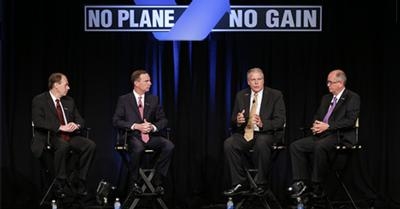Association President And CEO Ed Bolen Warns That The Issue Will Return
After two years of debate in Congress, proposals to privatize the ATC system in the U.S. were left out of Congress’s 2016 funding measures for the FAA, but NBAA President and CEO Ed Bolen warned the issue will return.

“This year, Democrats and Republicans in the Senate voted against it. It went nowhere in the House,” Bolen said in response to a reporter’s question at the No Plane No Gain Media Kick-Off Breakfast for NBAA’s 2016 Business Aviation Convention & Exhibition (NBAA-BACE). “However, because the big airlines seem to committed to pushing this, it’s inevitable privatized ATC will be part of the policy discussion going forward.”
The privatization proposal was only defeated this year by tireless work on Capitol Hill by NBAA, the General Aviation Manufacturers Association (GAMA) and their members across the country. In a discussion held hours before NBAA-BACE opened, the leaders of NBAA and GAMA explained why a privatized ATC system would be harmful to business aviation.
“About 50 percent of the hours we fly are international,” said Paul Anderson, vice president of UTFlight and chairman of the NBAA Board of Directors. “In the U.S., we can turn on a dime; the opposite is the case internationally.”
The ATC systems in other countries that advocates of privatization hold up as models are much less flexible and much more expensive, said Anderson. “My fear is the loss of that flexibility that makes business aviation such a productive and valuable tool.”
GAMA President and CEO Pete Bunce added the industry has concerns about splitting the FAA’s safety and air traffic functions. “In Canada, where they have a private ATC system, they’ve had budget problems with their safety function,” said Bunce. “They had no money to send regulators to work safety issues with their counterparts around the world.”
The NBAA and GAMA leaders also reported on their work to streamline the FAA’s certification process of new products and improve the consistency of regulatory interpretation by among FAA offices. The FAA has announced a single electronic database on regulations should be available to both agency employees and industry in 2017, reported GAMA Board Chairman Aaron Hilkemann.
Bolen also mentioned NBAA and GAMA’s efforts with U.S. Customs and Border Protection (CBP) to simplify reentry procedures to the U.S. for international flights, noting that CBP Commissioner Gil Kerlikowske was at NBAA-BACE to talk about that work.
In addition to policy, the association leaders talked about the economic issues facing the industry. In a wide-ranging discussion, they discussed the state of the business aircraft market; the progress of ADS-B equipage before the 2020 deadline; and outreach to bring a new generation of aviators and mechanics into the industry.
Bunce described NBAA and GAMA’s work on the International Civil Aviation Organization (ICAO) agreement for addressing carbon emissions from aircraft. “With the International Business Aviation Council (IBAC) and the FAA as our champions, we made sure the standards established are not onerous for business aviation,” he said.
Access issues were on the table too, such as the industry’s fight to preserve access at East Hampton and Santa Monica Municipal airports. “We’ve talked about policy at the international level, the federal level and even the local level,” said Bolen, “Regardless of what the challenge is, we as a community need to articulate why business aviation is valuable to this country.”
Bolen then unveiled the latest No Plane No Gain resources for communicating the industry’s value, including the newest Business Leaders on Business Aviation booklet and a new #BizAvWorks social media campaign.
(Image provided with NBAA news release)
 ANN's Daily Aero-Term (05.07.25): Terminal Radar Service Area
ANN's Daily Aero-Term (05.07.25): Terminal Radar Service Area ANN's Daily Aero-Linx (05.07.25)
ANN's Daily Aero-Linx (05.07.25) Classic Aero-TV: Anousheh Ansari -- The Woman Behind The Prize
Classic Aero-TV: Anousheh Ansari -- The Woman Behind The Prize NTSB Prelim: Bell 206B
NTSB Prelim: Bell 206B Airborne-NextGen 05.06.25: AF Uncrewed Fighters, Drones v Planes, Joby Crew Test
Airborne-NextGen 05.06.25: AF Uncrewed Fighters, Drones v Planes, Joby Crew Test



